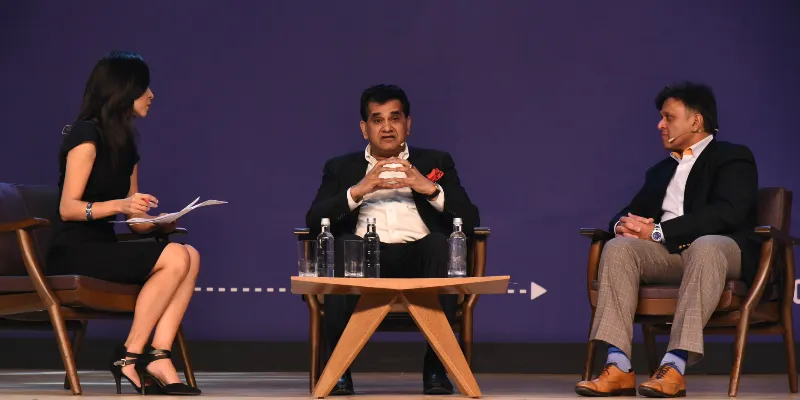Smart city isn’t only about hard infrastructure, it’s about smart people, says Amitabh Kant
NITI Aayog CEO says India will urbanise more in the next five decades than it has in the last 5,000 years and the challenge is to ensure sustainable and innovative urbanisation.
Launched in 2015, Indian government’s Smart City Mission aims to build 109 cities that “provide core infrastructure, a decent quality of life to its citizens, clean and sustainable environment and application of Smart Solutions”.
To achieve the mission, there is a strong need for using smarter solutions, wherein efficient urban mobility and public transport play a crucial role. In the last two years, the government has started work on 90 smart cities and, going ahead, the nation’s ambitious plan of ‘City of Tomorrow’ will turn into reality through a combination of conducive government policies, private infrastructure and public awareness.
Initially, the government only laid down broad principles about the mission and hasn’t set any one way of defining a smart city. Depending on a region’s development, resources, willingness to adapt and reform, resources and citizen’s aspirations, the conceptualisation may differ from city to city, and also among countries. So a smart city in India would be different in many respects from one in Singapore. Even within India, smart cities can have different connotations.
Therefore, the question still remains open –What is your idea of Smart Cities of the Future and what are the top elements that these futuristic cities should have?
Aiming to answer these questions, Amitabh Kant, CEO NITI Aayog, and Rajendra Rao, CEO, Ford Smart Mobility, engaged in a discussion on ‘Smart Cities of the Future’. The talk was moderated by Shereen Bhan, Managing Editor of CNBC-TV18.
The insightful conversation was one of the key highlights of Ford’s City of Tomorrow Symposium, aimed at exploring new ways of making our cities work better in the future through innovative uses of technology and collaboration between the public and private sectors.

The event, held in New Delhi on September 20, 2017,brought together opinion leaders, academics, innovators, policy makers and visionary TED fellows to share thought-provoking ideas on how to create a better tomorrow.
Smart cities: impetus to urbanisation
NITI Aayog CEO Amitabh Kant highlighted that American cities were made for cars, not for people and many of the city planners of the developing world have all been trained in America.
He explained that we have learnt the art of sprawling cities and the more infrastructure we create, the more cars we will have. Therefore the challenge is to reverse the process of planning, which will help in creating the shared, electric and connected vehicles of tomorrow.
“With 100 smart cities there is a lot of push towards urbanisation, but the challenge for India is to do innovative, compact and sustainable urbanisation,” the NITI Aayog CEO said.
However, he highlighted that citizens have also started working towards bringing in rapid urbanisation.
Amitabh Kant said the middle class in India was getting into governance and for the first time Maharashtra had a Chief Minister who had been a mayor of Nagpur city earlier.
“Suddenly we see a shift of politics from rural areas to cities and that will force change into cities.”
Finding efficient mobility solutions
NITI Aayog, a government initiative focused on catalysing development, and non-profit organisation Rocky Mountain Institute (RMI) have estimated a saving of about $60 billion through the rapid adoption of electric vehicles.
In a report titled India leaps ahead: Transformative mobility solutions for all, the Aayog projects that by 2030, India can save 64 per cent of anticipated passenger road-based mobility-related energy demand and 37 per cent of carbon emissions.
Amitabh Kant said India has several advantages when it comes to adopting electric mobility as compared to other nations.
“The per capita usage of cars in India is very low; it is only 20 per thousand whereas in America it is 800 per thousand. So moving from internal combustion to electric (zero emission) vehicles would be far easier. Secondly, in India 80 percent of transportation is within a radius of 5 km and therefore use of shared and connected vehicles will be far easier,” he added.
Rajendra Rao, CEO, Ford Smart Mobility,said: “The sharing economy will help in changing the notion of owning a vehicle, be it electric or internal combustion. It will bring in a radical change not only in ownership of vehicles but also how they are used.”
Focusing on India’s potential to emerge as an EV manufacturing hub, Kant said, manufacturers should not just try to address domestic demand for zero-emission vehicles, but also tap global markets.
“It cannot be business as usual because vehicle makers in India will be affected by what is happening globally. They have to think of addressing domestic demand and also think of scaling up in global markets, which will help in bringing down cost of electric vehicles,” Amitabh Kant explained.
Globally, the penetration of electric vehicles is 1.2 percent. By 2026, the price of an EV vehicle will match the price of a combustion vehicle; in terms of volume, electric vehicles are expected to takeover internal combustion vehicles by 2040.
Addressing the problem of power
Putting the spotlight on shared, connected and electric as the future of mobility in India, Amitabh Kant highlighted the need for the country to adopt a technology-agnostic approach as the last word on zero-emission vehicles, be it electric, hydrogen fuel or some alternate technology, has not been said.
With battery prices dropping, he envisioned 2030 as the tipping point for electric vehicles in the automotive industry, estimating battery costs to come down from $273 to $73 per kWh by then.
In terms of an environmental standpoint, Rao said recycling of batteries was highly important and promoted multiple use of batteries so that when they end their automotive life they can be recycled for domestic use or can be used to power homes/ offices.
Shifting the focus to India’s commitment for clean energy, Amitabh Kant revealed that India is making a huge shift towards solar power, producing 175 GW, and this indicates that the nation would be pushing for electric vehicles that can be charged from solar power and smart metering.
Defining a ‘City of Tomorrow’
After addressing the various issues and key elements of a smart city, especially efficient urban mobility and public transport, it was Amitabh Kant and Rajendra Rao’s turn to reveal their idea of a smart city.
“For me, the ultimate metric is human ROI, how happy are the citizens living in those cities and how free do they feel in the society. There should be no frustrationand anger, and they should be living in a freely mobile infrastructure,” Rao said.
Amitabh Kant had the last word: “A smart city should be technologically very creative, but it should also be culturally very creative. A smart city is not just about hard infrastructure, it’s about smart people.”







